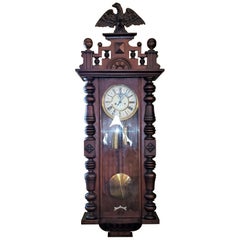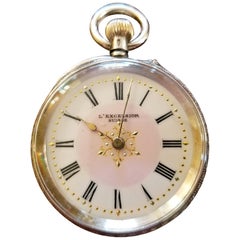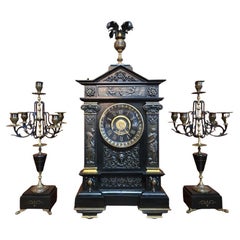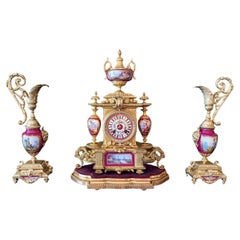Want more images or videos?
Request additional images or videos from the seller
1 of 7
19th Century British 8 Day Fusee Railway or School Wall Clock
Price:$1,600
About the Item
- Creator:J. Walker (Clockmaker)
- Dimensions:Height: 15 in (38.1 cm)Width: 15 in (38.1 cm)Depth: 5.5 in (13.97 cm)
- Style:Late Victorian (Of the Period)
- Materials and Techniques:
- Place of Origin:
- Period:
- Date of Manufacture:1880
- Condition:Wear consistent with age and use. Case and dial are mint. Fusee movement fully intact. It simply needs servicing to become fully operational.
- Seller Location:Dallas, TX
- Reference Number:1stDibs: LU3978112049623
About the Seller
4.9
Gold Seller
Premium sellers maintaining a 4.3+ rating and 24-hour response times
Established in 2015
1stDibs seller since 2018
395 sales on 1stDibs
Authenticity Guarantee
In the unlikely event there’s an issue with an item’s authenticity, contact us within 1 year for a full refund. DetailsMoney-Back Guarantee
If your item is not as described, is damaged in transit, or does not arrive, contact us within 7 days for a full refund. Details24-Hour Cancellation
You have a 24-hour grace period in which to reconsider your purchase, with no questions asked.Vetted Professional Sellers
Our world-class sellers must adhere to strict standards for service and quality, maintaining the integrity of our listings.Price-Match Guarantee
If you find that a seller listed the same item for a lower price elsewhere, we’ll match it.Trusted Global Delivery
Our best-in-class carrier network provides specialized shipping options worldwide, including custom delivery.You May Also Like
Mid 19th Victorian century carved mahogany fusee wall clock
Located in Debenham, Suffolk
Mid 19th victorian century mahogany fusee wall clock circa 1860.
Good quality English wall clock from the high Victorian period. White enamel dial with roman numerals, glass door w...
Category
Antique Mid-19th Century English Victorian Wall Clocks
Materials
Glass, Mahogany
Antique English 19th Century 8 Day Fusee Skeleton Cathedral Glass Dome Clock
Located in Dayton, OH
Antique mid 19th century 8 day skeleton clock. Centrally mounted on wood base featuring exposed Fusee movement and protected from dust by a glass dome.
Category
Antique Mid-19th Century Victorian Table Clocks and Desk Clocks
Materials
Glass, Hardwood
$1,840 Sale Price
20% Off
H 13 in Dm 9 in
Goliath Single Fusee Dial Clock or Station Clock
Located in Amersham, GB
This giant single fusee dial clock would have been made for a public space like a railway station. Made By Swinden and Sons of Birmingham, it has a su...
Category
Antique 1880s English Late Victorian Wall Clocks
Materials
Brass, Steel
Thwaites and Reed 19th Century Wall Clock
Located in London, GB
This beautiful wall clock was made by Thwaites and Reed in the late 19th century.
The case is mahogany and numbered 118 with a small ivorine plaque - these clocks were made for establishments such as the Inns of Court and the Bank of England in London. The company were also employed to service them.
The clock is wound with the original key and has a lovely deep tick tock (no chime). The diameter of the clock face is 30cm.
Thwaites and Reed are the epitome of a traditional English antique company...
Category
Antique Late 19th Century British Late Victorian Wall Clocks
Materials
Brass
19th-Century Pendulum Wall Clock
Located in Opole, PL
We present you this chain pendulum clock with a gravity winding mechanism with a single weight.
The case bears normal traces of long years of use.
It is intended to be renovated.
...
Category
Antique Late 19th Century Wall Clocks
Materials
Brass
Antique Wall Clock, Late 19th Century
Located in Chorzów, PL
The clock is functional, after the clockmaster review
Year: The end of the 19th century
Origin: Western Europe
Dimensions: Height 133 cm / width 42 cm / depth 17 cm.
Category
Antique Late 19th Century Belgian Other Wall Clocks
Materials
Oak
19th Century Johann Wien 90 Day Regulator Clock
Located in Tarry Town, NY
19th century hand carved oak case with carved capitals on full length waist columns and bracket feet, 90 day brass time only movement with deadbeat escapement and maintaining power t...
Category
Antique 1880s German Grandfather Clocks and Longcase Clocks
Materials
Brass
Vienna Regulator Wall Clock, 19th Century
Located in Hamilton, Ontario
19th century Vienna Regulator wall clock.
One weight Vienna Regulator with ornate carved head piece.
Category
Antique 19th Century Wall Clocks
19th Century French Tôle Wall Clock
Located in Charlottesville, VA
Decorated with finely detailed gilt foliate and bird motifs, this 19th century French tôle wall clock features a domed face with Roman numerals ...
Category
Antique 19th Century French Wall Clocks
Materials
Metal
19th Century Zinc 'Clock Tower' Antique Wall Clock
Located in Cirencester, GB
Sourced in the South of France we love the patina to this large zinc clock.
We have replaced the clock mechanism with a new battery high torque system.
Category
Antique 1890s French French Provincial Wall Clocks
Materials
Zinc
More From This Seller
View All19C Gustav Becker Vienna Wall Clock
Located in Dallas, TX
PRESENTING A GORGEOUS 19C Gustav Becker Vienna Wall Clock.
Made by the famous clockmaker, Gustav Becker circa 1880 in Germany.
Th...
Category
Antique Late 19th Century German Victorian Wall Clocks
Materials
Brass
19th Century Swiss Ladies L Excelsior Silver Pocket Watch
Located in Dallas, TX
Gorgeous little solid silver Swiss ladies pocket watch from 1880.
L'Excelsior Suisse
White and pink enameled face with gorgeous silver repousse work on rear with unmarked armor...
Category
Antique Late 19th Century Swiss Late Victorian More Clocks
Materials
Silver
19C French Mantle Clock with Candelabra Garnitures by J. Marti (Paris)
By Marti
Located in Dallas, TX
PRESENTING A STUNNING Mid 19th Century French Slate & Bronze Mantel Clock by Marti with pair of slate and bronze candelabra’s as garnitures.
This ‘large’ mantle clock, was made circ...
Category
Antique Mid-19th Century French Neoclassical Revival Mantel Clocks
Materials
Slate, Brass, Bronze
French 19C Japy Freres & Red Sevres Porcelain Mantle Clock with Garniture Set
By Japy Frères, Manufacture Nationale de Sèvres, Phillipe Mourey
Located in Dallas, TX
PRESENTING A STUNNING mid to late 19C French Japy Freres & Red/Magenta Sevres Porcelain Mantle Clock with Garniture Candlestick Ewers.
The clock movement is by the famous Parisienne Clockmaker … ‘Japy Freres’ and the clock dial has the marks for “JAY” (short for Japy Freres) & “Paris” on the dial face.
The clock mechanism and clock face/dial have matching serial numbers of “7225”. The movement also has the numbers: “5 – 2”.
The clock face/dial also has the initials: “D.H.”.
The gilt ormolu clock case is gilt spelter and is signed on the rear base, for having been made by “P.H. Mourey” of Paris, who worked with and for ‘Japy Freres’, towards the end of the 19th Century.
The signature of ‘Mourey’ also bears the numbers “85” … probably for 1885, but could also be the serial number.
Taking into account Mourey’s historical association with Japy, being late 19th Century, we are leaning heavily towards this being the date of manufacture i.e. 1885.
The Clock has RARE red/magenta Sevres hand-painted porcelain paintings/additions, to include:-
(i) a 2 handled and lidded urn on the crown with pointed flame finial,
(ii) a pair of bulbous urns either side of the main body and clock face,
(iii) the clock face and dial itself and
(iv) a flat rectangular medallion on the front base.
The crown urn and the base medallion both have similar themes, but different painted scenes, depicting French rural countryside scenes with cottages, rivers and bridges.
The porcelain urns on the sides, likewise have hand-painted images of a young boy, in rustic period attire on the right and a young girl on the left.
None of these paintings appear to be signed.
The clock case has GLORIOUS detail to it, with scrolls, ribbons, vines, grapes and Corinthian columns.
The clock sits on a custom made gilt wood and burgundy velvet plinth, that is original to the piece and was a common accent with ‘Japy Freres Clocks’, when originally retailed in their Paris shop.
The rear of the clock is plain and the perspex/clear resin plate insert, is a new addition, but a nice addition, in that it allows one, to view the movement and pendulum works.
The clock is an 8 day movement with a strike on the hour and half hour. The clock face has 2 winding holes … one for the pendulum movement and the other for the striking chime/ring.
Unlike British clocks this clock does not have a long musical chime … it is a simple ‘single strike’ on the half hour.
The red/magenta Sevres porcelain clock face/dial is in SUPERB condition. Roman numerals with gilt accents and a hand-painted circular wreath/bouquet of spring flowers on the center section.
To complete the set, we have a matching pair of gilt ormolu spelter and hand-painted red/magenta Sevres porcelain Ewers … which can hold a single candle each.
The porcelain urns on the central section, have hand-painted images of a young lady in rustic period attire … fishing on the riverbank on the right and a young man playing the flute in the countryside on the left.
The front base medallions on each ewer have hand-painted wreaths/bouquets of spring flowers.
The clock facing side of the porcelain urn on each Ewer, has a brass ormolu applique head, of the Greek god of wine-making, orchards and fruit, vegetation, fertility, festivity, insanity, ritual madness, religious ecstasy, and theatre, namely, Dionysus.
The plinths are signed on the rear top left corner, and we think they read: “R.P. Unfaut”. They also bear the numbers “61” and “69”, Again, possibly for 1861 and 1869, but here we think it is more likely they are serial numbers, as it is highly unlikely that a matching pair were made 8 years apart!
Whilst we cannot find any information on ‘R.P. Unfaut’, we can only guess that he/she/they worked with, or for, ‘Japy Freres’, as these ewers are unmistakably, a ‘superb’ match for the clock!
The style, subject matter, gold banding and edging, around the paintings, are virtually ‘identical’ to the same decorations on the clock’s porcelain paintings.
The Ewer on the left (with the boy playing the flute) appears to have a faded signature on the gold border of the painting towards the base and we think it is the signature of ‘Alexandre Evariste Fragonard’ …. one of the best known artists attached to Sevres in the mid 19th Century … meaning, that these Ewers were probably made circa 1845-50.
The quality and detail to these 2 paintings is classic Fragonard!
We are of the opinion, therefore that these garnitures, were made circa 35/40 years before the clock, as Mourey was prevalent with Japy around 1880 – 1900.
The clock paintings are of a very similar, rustic ‘Fragonard Style’ subject matter and although unsigned, could possibly have been painted by a Sevres artist, to replicate the Fragonard paintings...
Category
Antique 19th Century French Rococo Revival Mantel Clocks
Materials
Ormolu
Art Deco Portois and Fix Viennese Tall Case Clock
By Portois & Fix
Located in Dallas, TX
Presenting an amazingly rare piece of Art Deco furniture by an exceptionally rare maker, namely, an Art Deco Portois and Fix Viennese Tall Case Clock.
...
Category
Early 20th Century Austrian Art Deco Grandfather Clocks and Longcase Clocks
Materials
Brass
Early 19th Century British Mahogany Gothic Revival Wardrobe
Located in Dallas, TX
Beautiful early 19th century, circa 1830, William IV Period, mahogany Regency Gothic Revival wardrobe or armoire or linen press with central mirrored tabernacle and 5-drawer chest of...
Category
Antique Early 19th Century English William IV Wardrobes and Armoires
Materials
Mahogany
$3,600 Sale Price
47% Off
Recently Viewed
View AllMore Ways To Browse
J Walker
Fusee Clock
Antique Fusee Clock Clocks
School Clock
Antique Station Wall Clock Wall Clocks
Antique School Clocks
British Antique Clocks
School Wall Clock
8 Day Wall Clock
Antique Fusee Wall Clock
Wall Clock Fusee
Mid Century Modern Wall Clock
United Clock Vintage
1960 Clocks
19th Century French Wall Clock
Clock 1969
1970s Japan Furniture
Wall Clocks Germany



